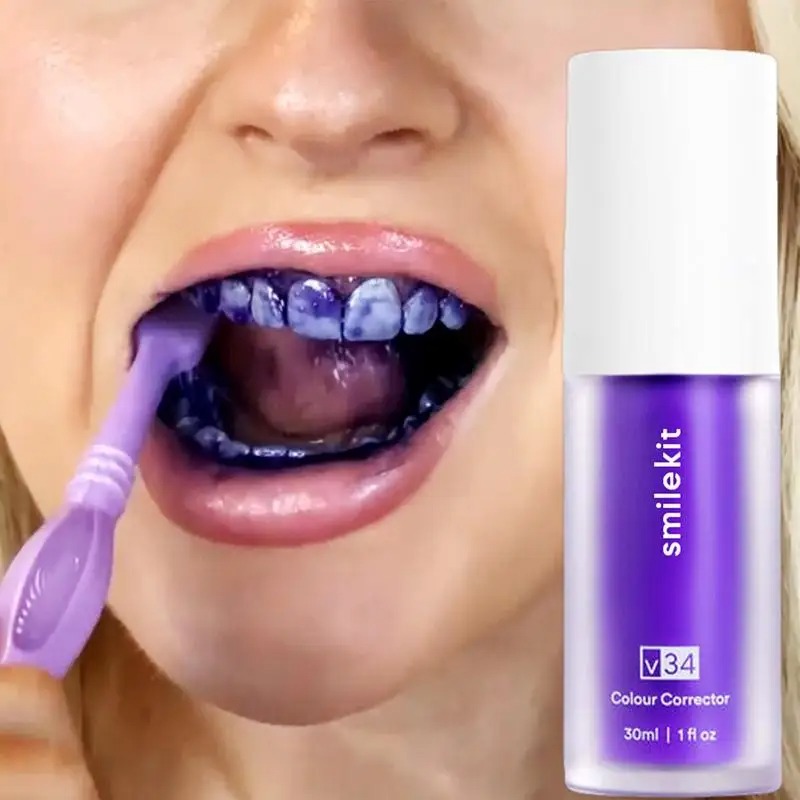Purple Toothpaste For Whitening

The quest for a brighter, whiter smile has led to the development of a wide range of oral care products, including the intriguing concept of purple toothpaste for whitening. At first glance, it might seem counterintuitive to use a purple-colored product to achieve white teeth. However, the science behind this type of toothpaste reveals a fascinating process that leverages the properties of specific ingredients to effectively remove stains and whiten teeth.
To understand how purple toothpaste works, it’s essential to delve into the chemistry of tooth discoloration. Teeth can become stained or discolored due to a variety of factors, including the consumption of coffee, tea, wine, and certain foods. These substances can lead to the formation of chromogens, which are pigmented molecules that bind to the tooth enamel, causing discoloration. The goal of any teeth whitening product, including purple toothpaste, is to either break down these chromogens or remove them from the tooth surface.
Purple toothpaste typically contains a combination of ingredients that work synergistically to achieve teeth whitening. One of the key components is often a purple pigment, such as a mixture of red and blue dyes, which is thought to have a-counteracting effect on the yellow or brown stains found on teeth. This concept is based on the principle of color neutralization, where the purple pigment acts to cancel out the unwanted yellow or brown hues, resulting in a whiter appearance.
Another crucial ingredient in purple toothpaste is usually a mild abrasive, such as silica or calcium carbonate, which gently removes surface stains from the teeth without damaging the enamel. These abrasives work by physically polishing the tooth surface, helping to eliminate minor discolorations and smooth out the enamel, which can contribute to a brighter, more even appearance.
In addition to the purple pigment and mild abrasives, many purple toothpastes include other active ingredients known for their teeth whitening properties. These can include enzymes like papain or bromelain, which break down protein-based stains, and oxidizing agents that help dissolve and remove chromogens. Some products may also contain desensitizing ingredients to help reduce sensitivity, a common side effect of teeth whitening treatments.
The effectiveness of purple toothpaste for whitening can vary depending on several factors, including the concentration and type of active ingredients, the frequency and duration of use, and individual differences in tooth enamel and the nature of the stains. While some users may experience noticeable whitening after a few weeks of regular use, others may not achieve the desired results.
It’s also important to note that purple toothpaste, like any other oral care product, should be used in conjunction with good oral hygiene practices, including regular brushing, flossing, and dental check-ups. Moreover, it’s crucial to follow the manufacturer’s instructions and to be patient, as teeth whitening is a gradual process that may require consistent effort over time.
For those considering trying purple toothpaste for whitening, it’s advisable to consult with a dentist, especially if you have sensitive teeth, gum recession, or other oral health concerns. A dental professional can provide personalized advice on the safest and most effective teeth whitening options tailored to your specific needs and oral health status.
In conclusion, purple toothpaste offers an innovative approach to teeth whitening, leveraging the principles of color neutralization and the action of mild abrasives and other active ingredients to remove stains and achieve a whiter smile. While its effectiveness can vary, and it should be used as part of a comprehensive oral care routine, purple toothpaste represents a fascinating and potentially useful tool in the quest for a brighter, healthier smile.
How does the purple pigment in purple toothpaste contribute to teeth whitening?
+The purple pigment in purple toothpaste is designed to counteract yellow or brown stains on teeth through the principle of color neutralization, helping to achieve a whiter appearance.
What other ingredients are typically found in purple toothpaste for whitening?
+Beyond the purple pigment, common ingredients include mild abrasives like silica or calcium carbonate, enzymes such as papain or bromelain, and sometimes desensitizing ingredients to reduce tooth sensitivity.
Is purple toothpaste suitable for everyone, and are there any potential side effects?
+While generally considered safe, purple toothpaste may not be suitable for everyone, particularly those with sensitive teeth or gums. Potential side effects can include increased sensitivity or gum irritation. It’s recommended to consult with a dentist before starting any new oral care product.
How long does it typically take to see results from using purple toothpaste for whitening?
+The time it takes to see results from purple toothpaste can vary significantly among individuals, depending on factors such as the severity of tooth discoloration, the concentration of active ingredients in the toothpaste, and individual oral health conditions. Some users may notice improvements within a few weeks, while others may require longer to achieve desired results.
Can purple toothpaste be used in conjunction with other teeth whitening methods or products?
+It’s generally advisable to consult with a dental professional before combining purple toothpaste with other teeth whitening products or methods. They can provide guidance on the safest and most effective approach for your specific oral health needs and goals.
What role does good oral hygiene play in the effectiveness of purple toothpaste for whitening?
+Good oral hygiene practices, including regular brushing, flossing, and dental check-ups, are crucial for maintaining oral health and maximizing the effectiveness of purple toothpaste for whitening. These practices help remove plaque, prevent tartar buildup, and ensure that the teeth and gums are healthy, making the teeth more receptive to whitening efforts.

